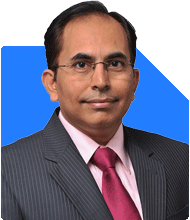Should I Rebalance Investments at age 63 with Rs 130 Lakhs?
Ramalingam Kalirajan |10183 Answers |Ask -Follow
Mutual Funds, Financial Planning Expert - Answered on Jul 16, 2024
He has an MBA in finance from the University of Madras and is a certified financial planner.
He is the director and chief financial planner at Holistic Investment, a Chennai-based firm that offers financial planning and wealth management advice.... more

Hi, I am 63 retired having Rs 130 lakhs in FDs. I have two apartments debt free and yearly medical insurance payment of 30000 please advise how to re-plan my investments to achieve maximum savings and with monthly expense of Rs 50000.
Age: 63 years old
Status: Retired
Investments: Rs. 130 lakhs in fixed deposits
Assets: Two debt-free apartments
Medical Insurance: Annual payment of Rs. 30,000
Monthly Expenses: Rs. 50,000
Investment Replanning Strategy
Emergency Fund
Recommendation: Keep Rs. 10 lakhs in a liquid fund or savings account for emergencies.
Reason: This ensures quick access to funds without penalties.
Monthly Income Generation
Recommendation: Invest Rs. 60 lakhs in a mix of debt mutual funds and Senior Citizen Savings Scheme (SCSS).
Reason: Debt mutual funds offer stability and better returns than FDs. SCSS offers attractive interest rates and is a safe investment for senior citizens.
Long-term Growth
Recommendation: Allocate Rs. 40 lakhs in balanced or hybrid mutual funds.
Reason: These funds balance risk and reward, offering potential for capital appreciation while providing stability.
Health Insurance
Recommendation: Ensure your health insurance covers adequate medical expenses.
Reason: Rising healthcare costs can deplete savings quickly.
Diversification
Recommendation: Diversify Rs. 20 lakhs across different investment vehicles like corporate bonds, gold funds, or international funds.
Reason: Diversification reduces risk and enhances potential returns.
Income Strategy for Monthly Expenses
Withdrawals: Set up a systematic withdrawal plan (SWP) from debt mutual funds for monthly income.
Monthly Withdrawal: Rs. 50,000 to cover monthly expenses.
Reason: SWPs provide a regular income stream while allowing the principal to grow or remain stable.
Final Insights
Emergency Fund: Maintain Rs. 10 lakhs in a liquid fund for emergencies.
Monthly Income: Use debt mutual funds and SCSS to generate monthly income.
Long-term Growth: Invest in balanced mutual funds for growth and stability.
Health Insurance: Ensure adequate coverage for medical expenses.
Diversification: Spread Rs. 20 lakhs across different asset classes for risk management.
Best Regards,
K. Ramalingam, MBA, CFP,
Chief Financial Planner,
www.holisticinvestment.in
You may like to see similar questions and answers below
Ramalingam Kalirajan |10183 Answers |Ask -Follow
Mutual Funds, Financial Planning Expert - Answered on May 23, 2024
Ramalingam Kalirajan |10183 Answers |Ask -Follow
Mutual Funds, Financial Planning Expert - Answered on May 29, 2024
Ramalingam Kalirajan |10183 Answers |Ask -Follow
Mutual Funds, Financial Planning Expert - Answered on Jul 01, 2024
Ramalingam Kalirajan |10183 Answers |Ask -Follow
Mutual Funds, Financial Planning Expert - Answered on Jun 16, 2025
Janak Patel |64 Answers |Ask -Follow
MF, PF Expert - Answered on Aug 04, 2025
Radheshyam Zanwar |6134 Answers |Ask -Follow
MHT-CET, IIT-JEE, NEET-UG Expert - Answered on Aug 04, 2025
Ramalingam Kalirajan |10183 Answers |Ask -Follow
Mutual Funds, Financial Planning Expert - Answered on Aug 04, 2025
Ramalingam Kalirajan |10183 Answers |Ask -Follow
Mutual Funds, Financial Planning Expert - Answered on Aug 04, 2025
Ramalingam Kalirajan |10183 Answers |Ask -Follow
Mutual Funds, Financial Planning Expert - Answered on Aug 04, 2025
Ramalingam Kalirajan |10183 Answers |Ask -Follow
Mutual Funds, Financial Planning Expert - Answered on Aug 04, 2025
Ramalingam Kalirajan |10183 Answers |Ask -Follow
Mutual Funds, Financial Planning Expert - Answered on Aug 04, 2025
Ramalingam Kalirajan |10183 Answers |Ask -Follow
Mutual Funds, Financial Planning Expert - Answered on Aug 04, 2025
Ramalingam Kalirajan |10183 Answers |Ask -Follow
Mutual Funds, Financial Planning Expert - Answered on Aug 04, 2025
Ramalingam Kalirajan |10183 Answers |Ask -Follow
Mutual Funds, Financial Planning Expert - Answered on Aug 04, 2025























